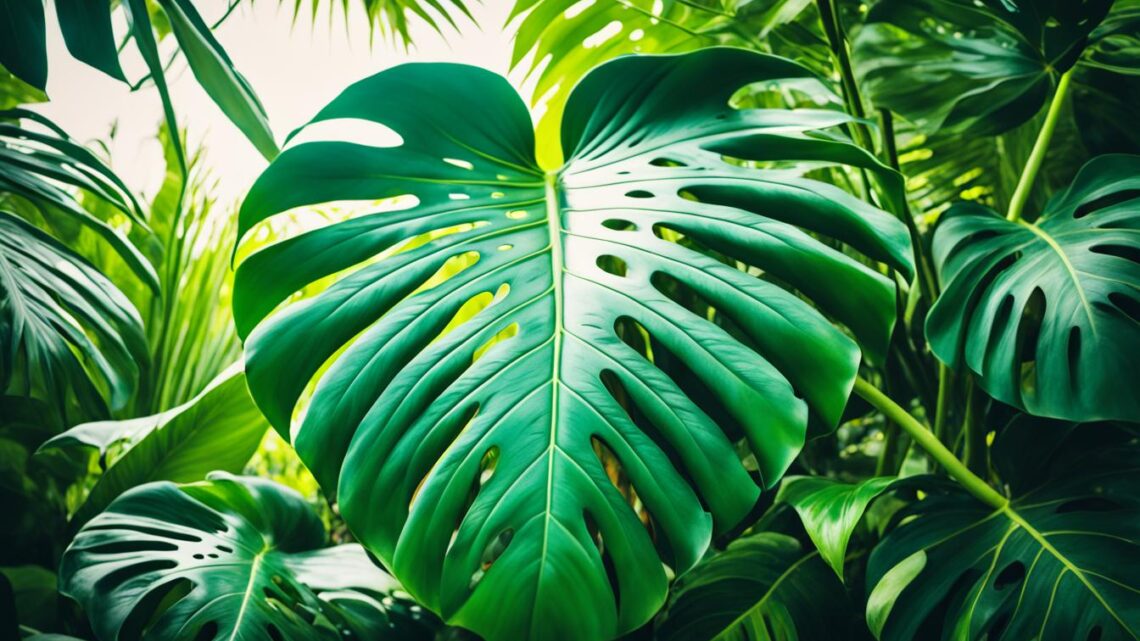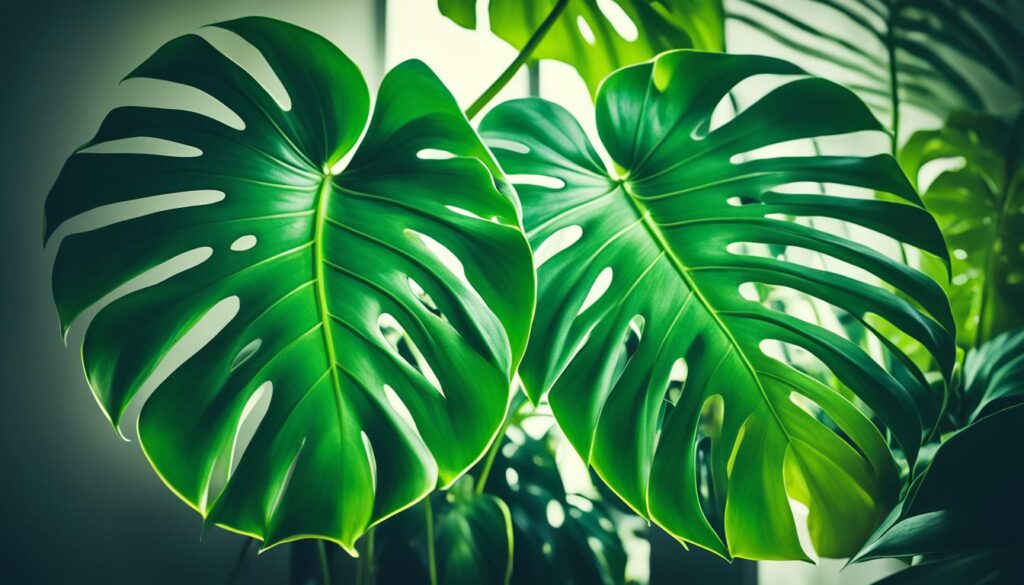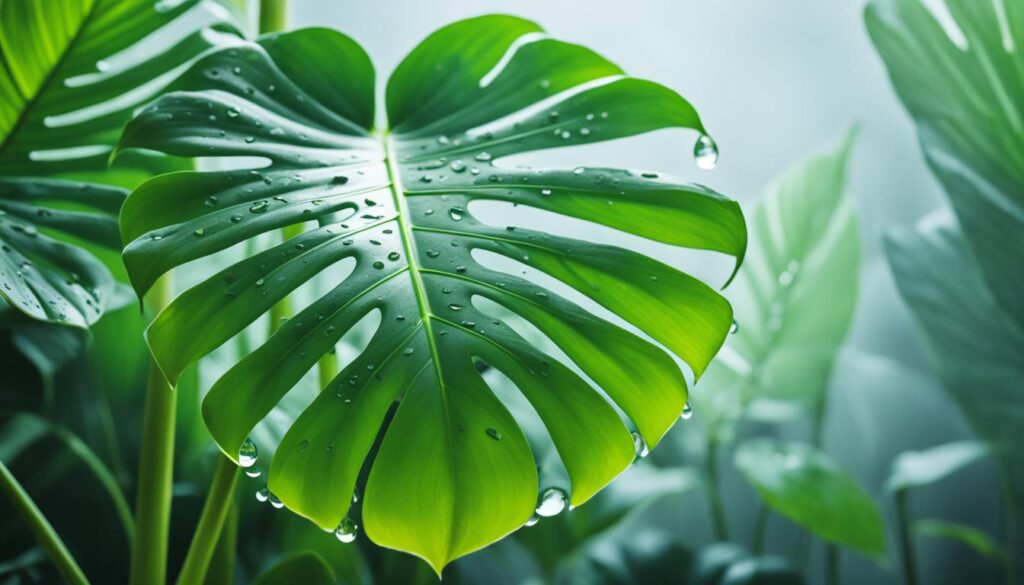
Do you dream of turning your indoor space into a lush, tropical oasis? The Monstera deliciosa, also known as the «Swiss Cheese Plant,» is perfect for this. It has large, split leaves with natural holes, adding a touch of the tropics to your home. Learn how to keep your Monstera healthy and vibrant, making it the centerpiece of your living space.
Why is the Monstera so popular among plant lovers? Its unique look and ability to purify the air make it a standout. Let’s explore the best ways to care for your Monstera, ensuring it thrives in your home.
About the Monstera Plant
Origins and Varieties
The Monstera deliciosa is a stunning plant from the Araceae family. It’s related to popular houseplants like philodendrons and anthuriums. Native to southern Mexico and Central America, it thrives in the rainforests, growing as a climbing vine up to 70 feet long.
The Monstera deliciosa is the most common houseplant type, reaching 6-8 feet tall indoors. But, there’s also the Monstera adansonii, known as the «Swiss Cheese Plant» for its unique holes. Other varieties include M. dubia and variegated ones like «Thai Constellation».
All Monsteras are known for their split and perforated leaves. These features help them survive in their native habitat. They allow the plants to manage water and nutrients well, even in heavy rain and wind.

Monstera plants are epiphytes, not parasites. They grow on other plants but don’t harm them. In the wild, their aerial roots attach to tree trunks and branches, reaching the forest canopy. This way, they get the light and humidity they need to stay healthy.
Light and Placement
Your Monstera plant needs bright, indirect light, like the dappled sunlight it gets in the rainforest. Place it near a sunny window but keep it away from direct sunlight. This can cause sun scorch and harm the leaves.
If one side of your Monstera leans towards the light, turn it regularly. This helps it grow evenly on all sides. A good spot is near a bathroom or kitchen window. Here, it gets humidity and filtered light it likes.
If your home doesn’t have enough bright, indirect light, use a grow light. This ensures your Monstera gets the light it needs. Variegated Monstera types, like the Monstera Deliciosa Variegata, need even more light than the green ones.
| Light Requirement | Recommended Placement | Potential Issues |
|---|---|---|
| Bright, indirect light | Near a sunny window, out of direct sunlight | Leaf scorch, stunted growth |
| Dappled sunlight | Bathroom or kitchen window | Leggy growth, smaller leaves |
| Supplemental grow light | Dark corners or during winter months | Lack of fenestrations, poor coloration |

Give your Monstera the right amount of bright, indirect light and adjust its spot as needed. This way, your plant will thrive and show off its beautiful leaves.
Watering and Humidity
Proper care for your Monstera plant means finding the right balance between water and humidity. These tropical plants do well with regular, moderate watering and more moisture in the air.
To water your Monstera, wait until the top 1-3 inches of soil dry out. Then, water until water drains from the pot’s bottom. Don’t let the soil stay wet all the time, as this can cause root rot.
It’s also key to increase the humidity around your Monstera. Mist the leaves often or put the pot on a pebble tray with water. If your home is dry, a small humidifier near the plant can help.
If your Monstera’s leaves curl or turn brown, it needs more humidity. The right mix of water and humidity keeps your Monstera healthy and lively indoors.

Monstera plants like humidity levels around 60% for best growth. Use a hygrometer to check your home’s moisture. Adjust as needed to make a great home for your tropical plant.
Monstera Soil and Fertilizer
Caring for your Monstera plant means choosing the right soil and fertilizer. Monsteras need a well-draining potting mix for good aeration and drainage. A mix of indoor potting soil, perlite, and shredded bark is perfect for these plants. It gives them the right balance of nutrients and air.
The best soil pH for Monsteras is a bit acidic, between 6.0 and 7.0. This pH helps the plant get the nutrients it needs for healthy growth. Feed your plant a balanced, diluted liquid fertilizer every few weeks in spring and summer. Make sure to follow the fertilizer instructions to avoid harming your plant with too much food.
Change your Monstera’s feeding schedule with the seasons. Cut back on fertilizing in fall and winter when the plant grows less. With the right well-draining potting mix and diluted liquid fertilizer, your Monstera will thrive at home.
| Soil Requirement | Fertilizer Recommendation |
|---|---|
|
|
Repotting and Pruning
When and How to Repot
Monsteras grow quickly and need to be repotted every 2 to 4 years. When it’s time, pick a pot a bit bigger than the old one. This gives the roots room to grow and keeps the plant healthy. You can also trim roots and foliage to keep the plant the same size.
Make sure the new pot has good drainage holes to prevent waterlogging. Use a fresh potting mix made for tropical plants when repotting. Loosen the roots and place the monstera in the new pot. Fill in around it with soil. For climbing monsteras, add a moss-covered stake or support to help them grow.
| Repotting Guideline | Percentage |
|---|---|
| Monsteras that need repotting based on symptoms (wobbly, pale, stopped growing) | 75% |
| Ratio of choosing a bigger pot vs. same pot with new soil | 60% – 40% |
| Recommended soil composition for repotting | 50% peat moss, 30% perlite, 20% compost |
| Percentage of old soil cut away when using the same pot | 30% |
| Standard pot size increase when repotting | 1-2 inches larger |
| Recommended recovery time after repotting | 2-3 months |
After repotting, put the monstera in a shaded spot for a few days. Water it well but don’t let it sit in water. Adjust the watering and cut back on fertilizer until it recovers fully.
Propagation Techniques
Monsteras are easy to spread through different methods. This lets you grow more plants and share the beauty of these lush, tropical plants. You can use stem cuttings, water propagation, or air layering. Each method has its own benefits and things to consider. Let’s look at these options to help you pick the best one for your Monstera.
Stem Cuttings
Stem cuttings are a simple way to grow more Monsteras. Choose a healthy stem section with a node and a leaf. Cut it just below the node. Then, put the cutting in water, making sure the node is under water.
In 2-4 weeks, you’ll see new roots starting. When the roots are a few inches long, move the cutting to well-draining soil. Treat it like a full-grown Monstera.
Water Propagation
Water propagation is another good way to grow Monsteras. Pick a healthy stem section with a node and a leaf. Put the node under water, keeping the leaf above the water.
Watch the cutting closely. In 2-3 weeks, you’ll see new roots. Then, move the cutting to soil.
Air Layering
Air layering is a more advanced way to grow Monsteras. Wrap a stem section, like a node, in damp sphagnum moss and cover it with plastic. Keep the moss moist for root growth.
Once roots form, cut the stem below the roots. Plant the new Monstera in its own pot.
Choose any propagation method, but make sure the cutting or air layer has enough root development before moving it to soil. With patience and care, you can grow more Monstera plants and share them with others.
| Propagation Method | Time for Root Development | Advantages | Considerations |
|---|---|---|---|
| Stem Cuttings | 2-4 weeks | Easy, straightforward, and can produce multiple new plants | Requires careful selection of cuttings and monitoring of water levels |
| Water Propagation | 2-3 weeks | Allows you to observe root growth, easy to monitor | Cuttings may be more delicate when transplanted to soil |
| Air Layering | Few weeks | Allows the plant to remain intact, produces a fully rooted new plant | More time-consuming, requires careful preparation and monitoring |
Pests and Disease Prevention
Common Issues and Solutions
Monsteras are easy to care for but can face pests and diseases if not looked after. Overwatering often leads to root rot. Underwatering makes the leaves wilt and turn brown. They might also get pests like mealybugs and spider mites.
Wiping the leaves with a damp cloth can keep pests away. If pests show up, use insecticidal soap or neem oil. These natural products work well against many pests.
Monsteras can get diseases like leaf spot, rust, and powdery mildew. Good watering, air flow, and using fungicides can help. Don’t water from above to avoid spreading diseases. Remove any infected parts right away.
Soft rot is a bacterial disease that quickly destroys the plant. To prevent it, make sure the soil drains well and don’t overwater.
Knowing how to handle pests and diseases keeps your monstera healthy and beautiful. With the right care and watchfulness, these plants can brighten your home for many years.
| Pest/Disease | Symptoms | Treatment |
|---|---|---|
| Mealybugs | White, cottony masses on leaves, stems, and petioles | Insecticidal soap, neem oil |
| Spider Mites | Yellowing leaves, delicate webs, speckles, leaf loss | Neem oil, increasing humidity |
| Thrips | Twisted or discolored leaves, premature leaf drop | Insecticidal soap, neem oil |
| Leaf Spot | Brown or yellow discoloration on leaves | Fungicide, removing affected leaves |
| Rust | Orange or brown pustules on leaves | Fungicide, improving air circulation |
| Powdery Mildew | White, powdery covering on leaves | Fungicide, improving air circulation |
| Soft Rot | Rapidly decaying leaves, stems, and roots | Improving drainage, avoiding overwatering |
Stay alert and act fast to keep your monstera healthy. Remember, it’s easier to prevent pests and diseases with good care. Keep up with the best practices to keep your plant safe.
Troubleshooting Tips
If your Monstera’s leaf tips turn brown, it might mean the soil is too dry. Or, the plant needs more consistent watering. Remove any leaves that are affected and change how often you water to keep the soil moist.
Yellow leaves with a halo around the discoloration could signal a fungal disease like leaf spot or powdery mildew. To prevent this, make sure the air around the plant moves well. Also, let the soil dry out a bit between waterings.
Watch your Monstera closely for any signs of trouble, like brown leaf tips, yellow leaves, or fungal diseases. If you see these, adjust its care to keep it healthy. This might mean better air flow, changing how often you water, or giving it the right kind of light.
By quickly fixing any problems and changing the plant’s care, you can help it stay healthy and full of life. Keeping an eye on your Monstera and fixing issues early will help it stay beautiful and strong.



